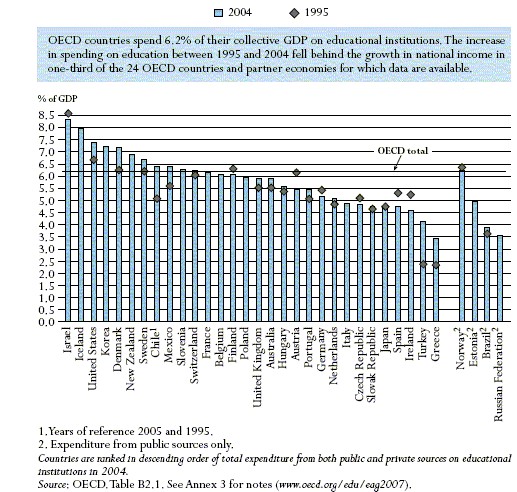TUAC NEWS
Education and Training: more investment by governments and employers is vital
18/09/2007
The new compilation of indicators on education released by the OECD, Education at a Glance 2007, emphasizes, according to John Evans, Secretary General of the Paris-based Trade Union Advisory Committee to the OECD (TUAC), that unions have to play a role in education and training. Unions “must push governments and employers to invest more in education and training. Moreover, they must continue to focus on the elimination of inequality in access as well as on the improvement of working conditions, access to training and career prospects for teachers. The way forward is to negotiate and to implement collective bargaining agreements with the aim to facilitate training. In doing so, unions can build on the positive role they have played so far in the process of developing skill formation”
Across OECD countries more students and young adults are completing upper secondary and tertiary education than ever before. Growth in educational attainment, which is highly welcome, reflects increasing demand for more and better education. Regrettably, however, most OECD governments have failed to address this demand appropriately. The expansion of education has neither been sufficiently accompanied by public expenditure nor by company-provided investment into job-related education and training. Moreover, inequalities with regard to access to education and training continue to exist. These are some of the key findings of Education at a Glance 2007, causing a number of concerns on the part of trade unions.
Importance of education and training: A persistent gap between political rhetoric and practice
In Australia, Japan, Korea, New Zealand, and the United Kingdom, increased participation in tertiary education caused governments to shift some of the financial burden to students and their families. So the share of tertiary spending from private sources rose substantially between 1995 and 2004 in these countries, most notably in Australia where the contribution of private funding between 1995 and 2004 increased by 9 percentage points.
In 2004 OECD countries spent on average 5.8 % of their collective GDP on educational institutions at the pre-primary, primary, secondary and tertiary levels (public and private expenditure on education combined). In the 23 OECD countries for which comparable trend data are available for all levels of education combined, public and private investment in education increased between 1995 and 2004 in real terms by at least 7%. However, in many OECD countries the increase in spending on education between 1995 and 2004 lagged clearly behind growth in national income. This was particularly notable in Austria, Spain, Ireland, Finland and Germany. With the exception of Finland, expenditure on educational institutions in these countries has fallen substantially below the OECD average. On the other hand, only a few countries such as Denmark, Iceland, Greece, Mexico and the US, have managed substantially to increase their total expenditure on education as share of GDP. Denmark and Korea in 2004 each spent 7.2 % of their GDP on education, the US 7.4 % and Iceland 8.0 %. (See chart below).
Like governments, many companies also failed to provide the necessary finance or resources to offer the workforce sufficient access to continuous vocational education and training. According to the new OECD indicators on education, there is not only substantial cross-country variation in participation rates in non-formal job-related continuing education and training: there is also evidence that all countries share serious inequalities in the incidence of adult learning. It is particularly striking that participation in further training is strongly determined by prior levels of educational attainment, sex, age and size of the company. According to the OECD,
- on average for the OECD countries surveyed, participation in adult non-formal job-related education and training is 14 percentage points higher for individuals who have attained a tertiary level of education than for persons who have only attained an upper secondary or post-secondary non-tertiary education;
- in most countries, participation in non-formal job-related learning declines with age, although the extent of the decline varies across countries,
- with the exception of few countries, among them Finland, France, the Netherlands and Portugal, men can expect to spend more hours in non-formal job-related continuing and education and training than women;
- based on previous research it must also be noted that working in unionized establishments substantially raises the probability of receiving training and the amount of training received.
Across the OECD, only Denmark, Finland, Sweden and the United States have managed to achieve participation of more than 35% of the population between 25 and 64 years of age in some type of non-formal job-related continuing education and training over a period of 12 months. However, in Greece, Hungary, Italy, the Netherlands, Poland, Portugal and Spain the participation rate was lower than 10%. Canada, Switzerland and the UK over twice this rate.
Expenditure on educational institutions as a percentage of GDP for all levels of education (1995, 2004)
This chart measures educational investment through the share of national income that each country devoted to spending on educational institutions in 1995 and 2004. It captures both direct and indirect expenditure on educational institutions from both public and private sources of funds.

For more information on the union reaction to “Education at a glance”, please contact Roland Schneider by email: schneider@tuac.org or tel. 33 (0)1 55 37 37 37.